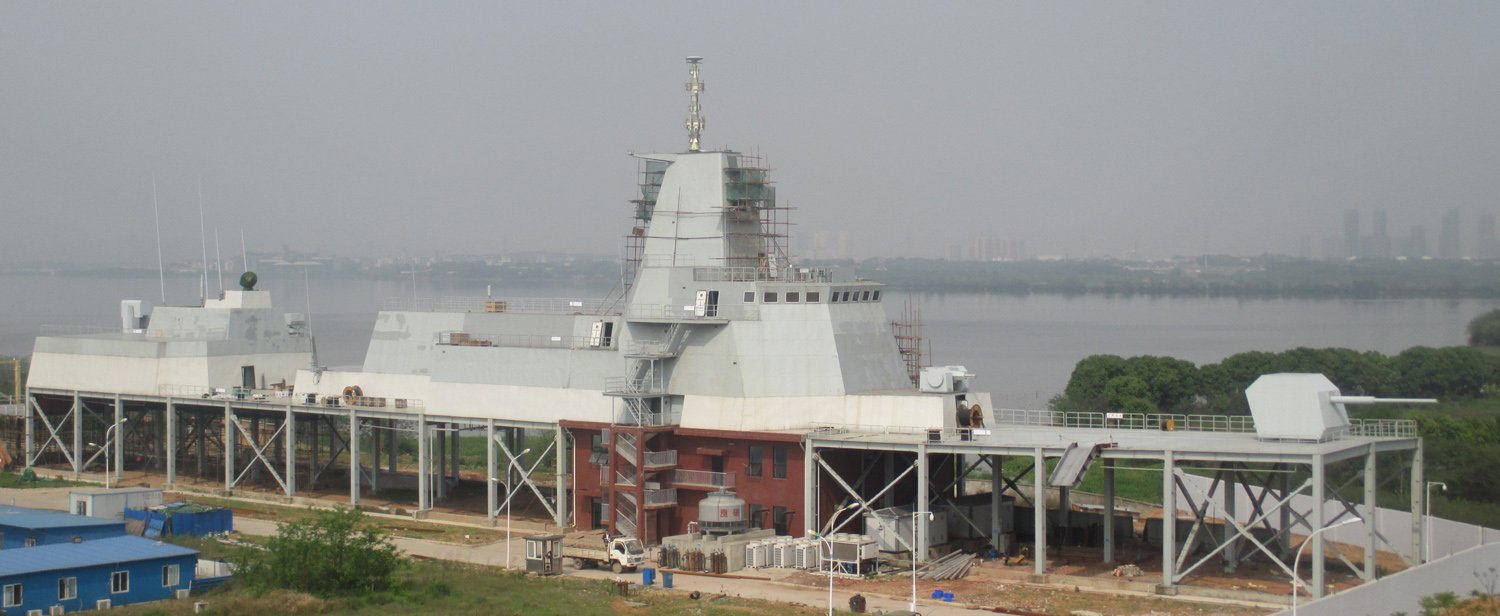

The Type 055 cruiser test rig in Wuhan is well on its way to opening for business. Built to test the Type 055’s sophisticated electronics and integrated stealth mast, the mockup now has major electronic sensors and systems installed, along with a coat of PLAN gray paint.

The Type 055 cruiser test rig made its Internet debut in March 2014 on Chinese websites. With a projected length of 160 to 180 meters, judging from the test rig’s 140 to150 meter length (which does not include the entire helicopter landing pad nor bow forward of the turret), and a width of about 21 to 23 meters, it would displace about 12,000 to 14,000 tons. That would make the Type 055 cruiser the largest Asian surface warship since World War II’s Japanese Tone class heavy cruisers.

The Type 055 cruiser is expected to command Chinese taskforces, act as the center of fleet air defenses against enemy air attacks, escort carrier groups and launch barrages of land attack and anti-ship missiles to project Chinese airpower. Judging from its 12,000 to 14,000 ton displacement, it could carry at least 112 to 128 vertical launch systems (VLS) cells for missiles. With that amount of firepower, the Type 055 cruiser could exceed the 122 VLS cells of the USN’s Ticonderoga class Aegis Cruisers.

The most obvious addition is the electronics support measures (ESM) mast installed on top of the integrated mast. ESM is the practice of collecting, processing and analyzing electronic activity by the enemy, in order to improve the performance of one’s electronics, and to calibrate electronic warfare systems. The ESM mast is mounted at the highest point on the Type 055 cruiser, in order to maximize its line of sight to pick up enemy electronic activity such as radars, communications and jamming.

Located on top of the bridge superstructure, the integrated mast has three radar arrays. While the specific model of these radars is yet unclear, the radars are likely to be for purposes of fire control for surface to air missiles (SAMs), navigation and identification friend or foe (IFF) transmitter. While only the forward side of the integrated mast has the radar arrays installed, the Type 055 cruiser will have all three radars on each side of the integrated mast.

Type 346X radars may have been installed, though the available photos make it difficult to ascertain. The Type 346 family of radars have already been installed on the Type 052D Luyang III destroyers, and are large multipurpose, electronically scanned radars that are comparable to the U.S.’s SPY-1 radars on Aegis warships.

The purpose of building such a mockup is to test electronic interaction/interference between the Type 055’s multiple radars, communications and other electronic equipment in the real world. Conducting such tests before launching the first Type 055 cruiser allows for modifications to the electronics set up to be more easily changed, as well as on site support from electronics laboratories. However, the test rig is not an accurate representative of actual Type 055 layout (the helicopter hangar in the rear has no door, and no anti-stealth radar has been installed over it, as is the case with the Type 052C and Type 052D destroyers).

When the Type 055 cruiser test rig turns on, the airwaves in Wuhan will get a lot more crowded. Once the Chinese launch the first Type 055 cruiser, the waters in the western Pacific, and around the world, are also going to get pretty crowded too.
Edit: Thanks to Blitzo for pointing out the correct designation of the CJ-10 LACM.
You may also be interested in:
Chinese Navy Stars in Latest U.S. Intelligence Report
Chinese Shipyard Looks to Build Giant Floating Islands
Learning More About China’s Massive Warship Plans (055 Cruiser)
